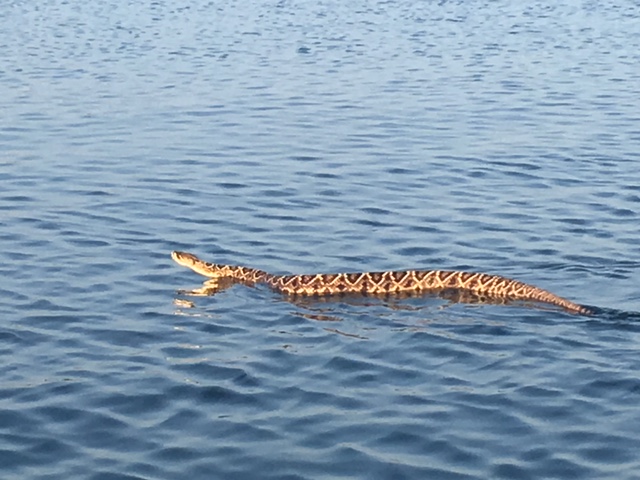
by Rick O'Connor | Sep 28, 2018
In the past week, three eastern diamondback rattlesnakes were encountered near the Ft. Pickens area on Pensacola Beach. The first was at a condominium unit near the park gate where construction work was occurring, the second was found swimming in the surf of the Gulf of Mexico within the national seashore, and the third was in the national seashore’s campground. This is an animal we rarely encounter on our barrier islands – but that is the keyword… encounter… they are there, but tend to avoid us.
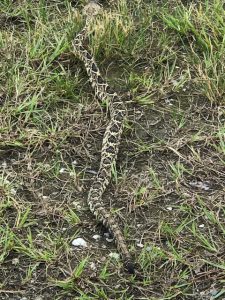
Eastern diamondback rattlesnake crawling near Ft. Pickens Campground.
Photo: Shelley Johnson
Report on rattlesnake in Gulf surf –
https://www.pnj.com/story/news/local/2018/09/26/snake-rescue-pensacola-beach-shocks-visitors/1430731002/
The eastern diamondback rattlesnakes (Crotalus adamanteus) is the largest venomous snake in the United States. An average snake will reach six feet and five pounds, but they can reach eight feet and up to 15 pounds. Because of their large bodies, they tend to move slow and do not often try to escape when approached by humans. Rather, they lie still and quite hoping to be missed. If they do feel you have come to close, they will give their signature rattle as a warning – though this does not always happen. If they are considering the idea of striking – they will raise their head in the classic “S” formation. Know that their strike range is 2/3 their body length – larger than many other native snakes – so a four foot snake could have a three foot strike range. Give these snakes plenty of clearance.
Eastern diamondback rattlesnakes prefer dry sandy habitats, though they are also found in pine flatwoods (such as Naval Live Oaks north of highway 98 in Gulf Breeze). They are quite common in the upland sandhills of longleaf pine forests. They spend the day in tree stump holes and gopher burrows and hunt small mammals and birds in the evenings. They are particular fond of rabbits. The dunes of our barrier islands are very similar to the sandhills of the pine forest further north. They are actually good swimmers and saltwater is not a barrier – distance is. They have been seen numerous times swimming from Gulf to Pensacola Beach or the opposite. Again, they tend to avoid encounters with humans and are not often found on lawns etc.
Diamondbacks give birth to live young around August. The females will find a dark-cool location to den and give birth several young. Anywhere from four to 32 offspring have been reported. The female remains with the young for about 10 days until they have their first molt (skin shedding) and then she leaves them to their fate.
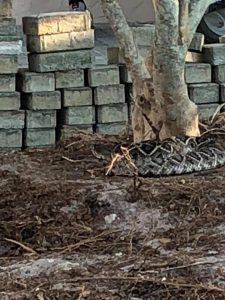
Diamondback rattlesnake near condominium construction site Pensacola Beach.
Photo: Sawyer Asmar
So what’s up with three encounters in a relatively small location within one week?
My first inclination is two possibilities – maybe a combination of the two.
- We have had a lot of rain this year – and then T.S. Gordon came through. Snakes like to be on high dry ground as much as anyone else and they tend to move closer to human habitats because they are built on higher ground.
- Breeding season for eastern diamondbacks is late summer early fall. This time of year, the males are on the move seeking interested females – so they are encountered more.
As far as finding one in the surf of the Gulf of Mexico. I am not sure. I have never seen this and the newspaper account suggested it was not doing well when found. Again, I have seen plenty swimming the Intracoastal but this is a first for the Gulf. I would say it had wondered the wrong way.
They are actually fascinating animals and are not a threat unless you approach too close. Give them room and feel lucky if you get to see one.
References
Eastern Diamondback Rattlesnake. Natural History. Center for Biological Diversity. https://www.biologicaldiversity.org/species/reptiles/eastern_diamondback_rattlesnake/natural_history.html.
Krysko, Kenneth L., and F. Wayne King. 2014. Online Guide to the Snakes of Florida. Florida Museum of Natural History, University of Florida, Gainesville, FL, USA. [Online: September 2014] Available at: http://www.flmnh.ufl.edu/herpetology.
https://www.floridamuseum.ufl.edu/herpetology/fl-snakes/list/crotalus-adamanteus.
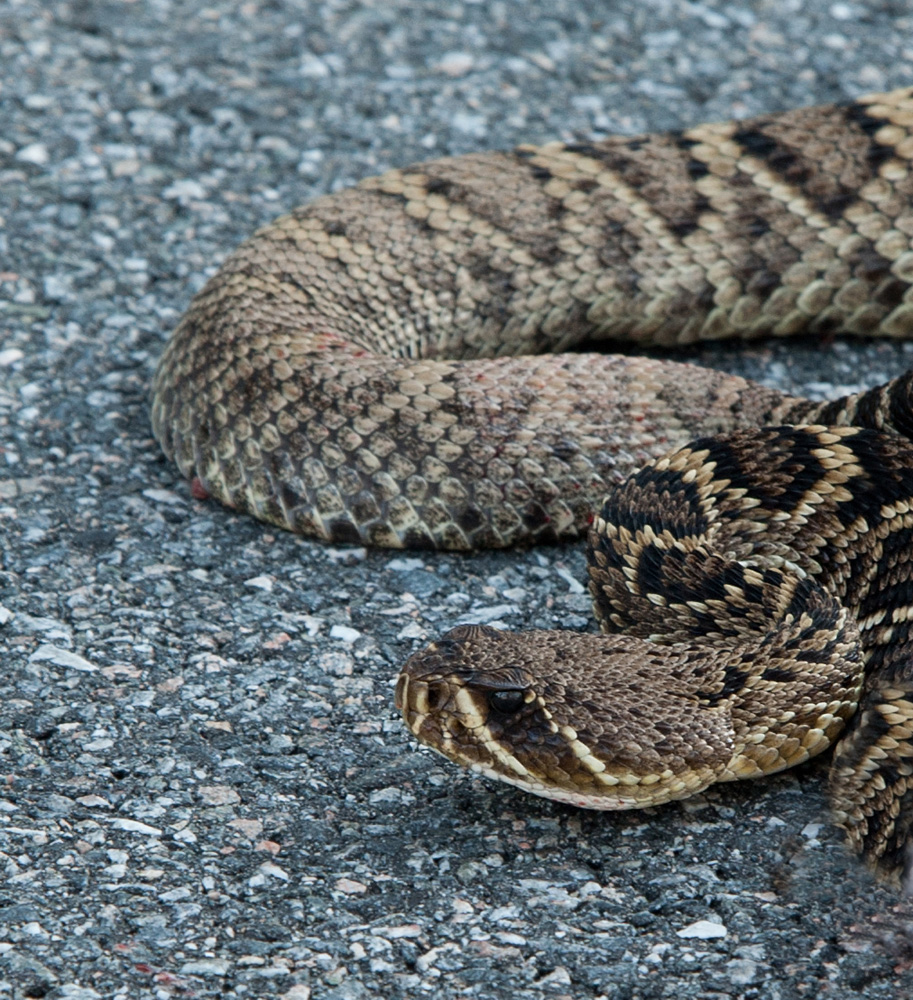
by Rick O'Connor | Dec 8, 2017
The observations I made of rattlesnakes is just that… observations, there is no scientific study I am aware that supports what I appear to have seen, but I have noticed it – more than once now.
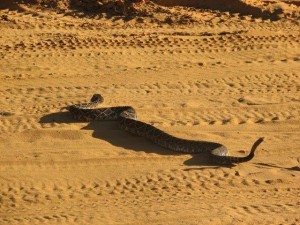
Eastern Diamondback Rattlesnake crossing road at Eglin AFB. Photo: Carrie Stevenson
The eastern diamondback rattlesnake (Crotalus adamanteus) is a legendary animal in the southeast United States. William Bartram mentions it several times during his travels through Florida in the 1770’s. His Florida nickname “Pug Puggy” actually came from an incident where he killed a large one in a garden of a Seminole camp. Almost every story about the colonial/settling period of state, whether fiction or non-fiction, includes this snake. They are the largest venomous snake in the U.S., reaching up to six feet, and can have the girth of a man’s arm. They have a large head, holding large venom glands, and have a strike range of 33% their body length – the stuff of legends.
However, few people of died from this animal. One website list 53 fatal snakebites in the United States since 1900, 11 are listed “prior to 1900”. Of the 53 snakebites, 34 (64%) were from rattlesnakes – all 11 (100%) of the “prior to 1900” were rattlesnakes. However, there are a reported 16 species of rattlesnakes in the U.S., only three live in the southeast. From this list, there are only three confirmed Eastern Diamondback bites (5%), and an additional 7 that “may” have been. They were identified as rattlesnakes and the victims lived in the southeast, but the bite could have been from the timber or pygmy rattlesnake. The vast majority of lethal rattlesnake bites come from out west. Granted, in the early part of our state’s history many rattlesnake bites went unreported, however 3 confirmed deaths (10 possible) since we became a state is not that many when compared to the number of Floridians who have died in automobile accidents or violent crimes. That said, this is still a legendary animal that many fear, and the snake lives on Pensacola Beach.
In the past month, I have received several photographs of the eastern diamondback seen in the National Seashore. The observation – they seem to be more common when we are not around. No doubt, they were probably once common on the island. Many are surprised by this because the only way to access Santa Rosa Island, initially, was to swim – but rattlesnakes are good swimmers. They do not prefer the water, but have no problem crossing it. They are primarily consumers of rodents, taken prey as large as rabbits if they can, and hunt primarily at night – so viewing during the day is not common.
However, when the road to Pickens was closed after Hurricane Ivan, daytime encounters with eastern diamondbacks increased. There were numerous reports of individuals seeing them moving around the park. Then the road re-opened, and no one saw them anymore. Hurricane Nate caused enough damage that the park, once again, had to close for repairs – and the photos began to come in. It will be interesting to see if the number of encounters begins to decline no that it has re-opened. Are these snakes aware of our presence and seek refuge? It would be nice to know they did, but both Ivan and Nate arrived in the fall when rattlesnakes begin to move for breeding. How many of these snakes would be seen whether the road was open or not. I know when the road is open I do not hear as much from the public. I also know that recently FWC was requesting reports of encounters with this snake because they feared it was declining across the state. Along with several other species of local snakes – such as the Southern Hognose (Heterodon simus) and the Florida Pine Snake (Pituophis melanolucas migitus), they were asking the public to report sightings. They recent removed the eastern diamondback from this list – suggesting that encounters were more common than they thought. Again, maybe a case of “I’m here but I’m hiding”.
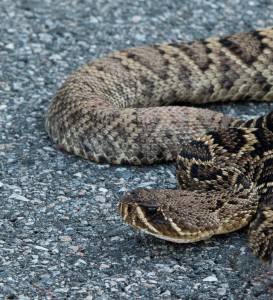
The familiar face of an Eastern Diamondback Rattlesnake.
Photo: Nick Baldwin
For me, it is an interesting observation. I find the animal fascinating, maybe because of its legendary status and rare encounters, but I find it fascinating nonetheless. I certainly understand the safety concerns with having this animal so close to us, but the records of bites and fatalities suggests the threat is not as large as we perceive it. I would certainly recommend homeowners maintain their property as to reduce the risk of an encounter, but know most do – or else you would be seeing more of them. As with sharks, I for one am glad to know they are still around.






